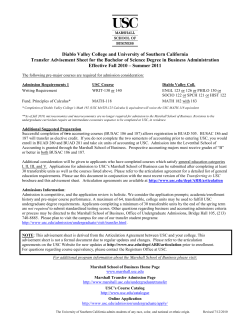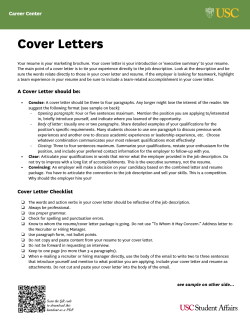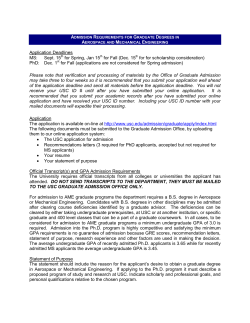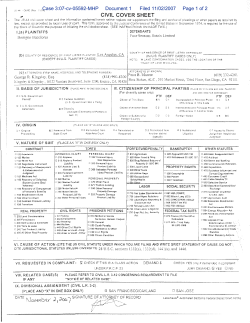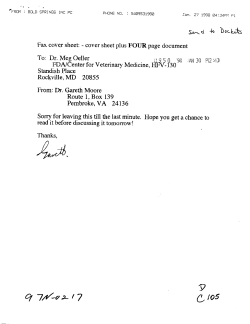
Weekly The Sample lauds faculty, touts progress in emotional final address
FEBRUARY 5 • 2010 Weekly The PUBLISHED FOR THE USC HEALTH SCIENCES CAMPUS COMMUNITY VOLUME 16 • NUMBER 4 Sample lauds faculty, touts progress in emotional final address USC President Steven B. Sample’s last address to the faculty on Jan. 26 at Town & Gown was marked with warm and poignant moments, as well as sustained standing ovations before and after he spoke. Sample told the group that when he arrived on campus in 1991, he encountered “something really wonderful— a faculty who were willing to cut me some slack.” He said that he and his wife, Kathryn, realized early on how fortunate they were to be part of a university where the term “family” had real meaning and where lifelong bonds were a reality, especially among alumni. But the people key to bringing his dreams to fruition were “the people who actually do the teaching, research, public service and patient care. “At the heart of our efforts are excellent faculty who are highly motivated, who believe in the goals and the mission of this university,” he said. For example, one of the initial goals of Sample’s presidency was developing the Health Sciences Campus into a world-renowned center for clinical care and research, and he acknowledged “the pivotal role” that faculty played when the university took a major step in that direction. “Many members of our medical faculty kept working, kept believing and kept guiding the university until eventually we took the bold and salutary step” of purchasing USC University Hospital and the USC Norris Cancer Hospital. He cited the purchase of the hospitals as “an opportunity to do something well to make our mark.” The president’s talk contained the trademark Sample wit, including an opening joke and jaw-dropping statistics that illustrated how far and fast the university has risen in his 19-year tenure. It was Steve Cohn By Allison Engel and Ina Fried Before his final address to the faculty, USC President Steven B. Sample (left) was introduced by Alex Capron, president of the faculty and Distinguished Professor of Law and Medicine in the USC School of Law and Keck School of Medicine of USC. only at the end of his upbeat assessment that his voice faltered with emotion. Sample talked about not “copying your way to excellence” and how USC used original thinking and unconventional approaches to differentiate itself from its academic competition. A pared-down strategic plan that emphasized undergraduate education, interdisciplinary research and teaching, internationaliza- USC Norris inpatients to begin shift to USC University Hospital “It’s not the case that all of us, eventually, will have bar codes that we can take to our doctor that will induce him or her to write prescriptions that will immunize us against the health risks that our genome is suggesting,” said Kennedy. “We don’t know anything, automatically, based on the genetic sequence, about the expression level of that particular gene. It’s a very difficult business.” While he did not dismiss the possibility of utilizing genetic information to better understand By Tania Chatila See KENNEDY, page 2 Jon Nalick Donald Kennedy, Bing Professor of Environmental Science and President Emeritus at Stanford University, spoke on Jan. 29 about the promise of—and the problems associated with— the human genome map and society’s use of it, both for medical and forensic uses. Held in the Aresty Conference Center, the lecture, “The Bumpy Road to Personalized Medicine,” offered a nuanced view of the value of genetic information for both scientists and society. His presentation was the first in a planned seminar series on translational medicine organized by Keck School of Medicine Dean Carmen A. Puliafito. Jon Samet, chair of the Department of Preventive Medicine at the Keck School, introduced Kennedy as someone who “has made the right enemies, and therefore must be doing the right things”—a reference to Kennedy’s position as editor of the journal Science from 2000-2008, where he became a lightning rod for criticism for his willingness to speak out about the intersection of science and politics. In his presentation, Kennedy said the complete mapping of the human genome, first announced in 2000, held much promise for scientists, researchers and physicians. Labeled the “blueprint of life,” by leading scientists, the human genome sequence was going to usher in a new age of truly personalized medicine, such as preventive therapies to preclude diseases predicted by the presence of certain genes. However, Kennedy noted, the promise has not yet been fulfilled, due in large part to the lack of understanding of the epigenome, which can control the expression of genes. The discovery of the epigenome has added another layer of variability into the process of managing and preventing disease on a genetic basis. —USC President Steven B. Sample See SAMPLE, page 4 Renowned environmental scientist sees unfulfilled promise in mapped genome By Sara Reeve ‘At the heart of our efforts are excellent faculty who are highly motivated, who believe in the goals and the mission of this university.’ Donald Kennedy discusses “The Bumpy Road to Personalized Medicine” at his Jan. 29 lecture. In an effort to expand and improve patient care facilities, USC University Hospital will begin treating all USC Norris Cancer Hospital inpatients and handling all Norris surgical cases beginning March 1. Administrators say the plan is part of a larger initiative to provide enhanced facilities for all patients at USC hospitals—starting with the opening of the Norris Inpatient Tower at USC University Hospital to treat USC Norris Cancer Hospital inpatients come March 1. Meanwhile, administrators will also take this time to identify key expansion and upgrade opportunities at the Norris facilities. “This is really about providing the best possible opportunities for improved facilities for our patients,” said hospitals CEO Mitch Creem. “By caring for our cancer patients at USC University Hospital, we will finally have the long-awaited opportunity to treat patients in the brand new, state-of-the-art Norris Inpatient Tower. At the same time, we’ll also have a chance to look at the best possible ways to utilize our Norris facilities in the future for our patients.” Months of preparation have gone into the March 1 transition effort, and plans are in place to ensure smooth operations. Ingrid Nouri, a clinical coordinator also on the medical/surgical floor at USC Norris Cancer Hospital, commended administration’s efforts to prepare staff and physicians for the transition. Nouri, who worked at USC University Hospital for 10 years before arriving at USC Norris Cancer Hospital four years ago, said she has also been trying to help her colleagues prepare for March 1. “I feel like I am able to assist in the transition because I have been there and I have also been here.” Surgery schedulers have begun arranging for patient cases on or after March 1 to be completed at the USC See INPATIENTS, page 3 FEBRUARY 5 • 2010 CHLA awarded $4.7 million grant for leukemia program The Bogart Pediatric Cancer Research Program has awarded a five-year $4.7 million grant to support the Childrens Center for Cancer and Blood Diseases (CCCBD) and the creation of the Bogart Leukemia Research Program at Childrens Hospital Los Angeles. The grant also will support 25 scholarships and personal laptops for pediatric cancer survivors entering college. Stuart E. Siegel, director of the CCCBD and professor and vice chair of pediatrics at the Keck School of Medi- Computer speech project to boost doctor-patient communication By Joe Peters A program funded by USC’s Clinical Translational Science Institute is helping create a computerized speech translation system to be used in clinics and hospitals to bolster communication between physicians and patients. Led by Shrikanth Narayanan of the USC Viterbi School of Engineering, the SpeechLinks Project team includes two researchers from the Keck School, professors Win May and Lourdes BaezcondeGarbanati. SpeechLinks, a speech-to-speech translation system for clinics and hospitals, is designed to translate between English and Spanish. In practice, doctor and patient are connected by two headsets to a computer that performs the translation in near real time. The system is designed to learn from its encounters, referring tougher translation problems to a human translator who can review the entire conversation and fill study of its kind in the in the gaps where the United States—one machine is having that deals with the trouble translating. Spanish-speaking popThe doctor may also ulation. In developing elect to refer the conthe Spanish vocabuversation to a human lary of the system, translator if necessary. they are attempting Lourdes While their colto build a “culturally Baezconde-Garbanati leagues at the Viterbi intelligent” tool. School develop the Both hope that technical infrastructure this system can help for the system, May assist overburdened and Baezconde-Garinterpreters in banati draw on their public health systems medical and cultural like Los Angeles experience to develop County’s, or in Win May test cases with which remote areas without to ‘train’ the system. access to interpretAs May notes, “In translaers. Baezconde-Garbanati, tion, if you don’t understand who studies the role of the cultural context, the culture in health behaviors, translation may not be as efsaid, “Competent current fective as you want it to be.” interpreters are maxed out Baezconde-Garbanati in terms of the demand. described their role as develLeaving simultaneous interoping “alternative culturpretation to family members, ally relevant scenarios,” to janitors in the hallway, or test the system, including children is a thing of the “important cultural values past… [SpeechLinks] could and variations in cases and help them make decisions disease conditions.” As she regarding where to send their explained, this is the first precious resources.” KENNEDY: Expert questions legal criteria for DNA ‘matches’ Continued from page 1 and treat disease, Kennedy told the audience that it would require a more sophisticated understanding of both genetics and epigenetics. “And then we’ll know how much use this whole area of investigation will be to clinicians who are trying to help other human beings,” he said. Kennedy’s questioning of the value of genetic information continued with an examination of the usage of DNA evidence in the prosecution of criminal cases. According to his presentation, the criteria by which law enforcement officials may declare that an individual’s DNA matches that present at a crime scene appears to be too broad. However, federal law enforcement agencies have decided not to allow scientific access to state and national DNA databases. “Scientific enterprise can surely tolerate strong differences of view if there is good access to the content of the argument,” Kennedy said. “But it’s a different matter when an important part of the judicial system simply walks away and refuses to permit analysis of the data. It is employed to make vital judgments about the fate of human lives… I think that’s a bad system.” A webcast of this seminar can be found at http://tinyurl.com/ydoxuxd. The Weekly Next Issue: July 24 The Weekly is published for the faculty, staff, students, volunteers and visitors in the University of Southern California’s Health Sciences Campus community. It is written and produced by the Health Sciences Public Relations and Marketing staff. Comments, suggestions and story ideas are welcome. Permission to reprint articles with attribution is freely given. Associate Senior Vice President, Health Sciences Public Relations and Marketing: Jane Brust Executive Director of Communications and Marketing: Ina Fried Editor: Jon Nalick Contributors: Eva Blaauw, Tania Chatila, Meghan Lewit, Carol Matthieu, Katie Neith, Joe Peters, Sara Reeve, Leslie Ridgeway and Bryan Schneider Senior Vice President, University Relations: Martha Harris Phone: 323-442-2830 Fax: 323-442-2832 E-mail: hscwkly@usc.edu Web: theweekly.usc.edu RSS: http://www.usc.edu/hscw cine, and Robert C. Seeger, a physician-researcher with the CCCBD and professor of pediatrics at the Keck School, will direct the research being funded. Carmen A. Puliafito, dean of the Keck School of Medicine, hailed the award as providing a major boost for crucial research, adding that it “underscores the depth of the Bogart Pediatric Cancer Research Program’s commitment to—and passion for— the work of our physicianresearchers.” Over the past 25 years, the Bogart Program has awarded nearly $27 million for cancer research at Childrens Hospital Los Angeles. “The Bogart Pediatric Cancer Research Program has been critical to our efforts to find new treatments for children with cancer,” Siegel said. “Their support allows us to rapidly move new discover- ies in the lab to the bedsides of young patients, and has led to a number of major advances in treating and curing pediatric cancers.” Seeger said, “The greatest accomplishment of the Bogart Laboratories over the past 25 years is a major improvement in understanding and treating high-risk neuroblastoma, the most common cancer that occurs outside the brain in children. New treatments developed by Bogart investigators have improved survival rates from 15 percent 20 years ago to 45-50 percent now. This has had a worldwide impact.” The Bogart Pediatric Cancer Research Program was founded in 1984 and named in memory of Neil Bogart, a record and film executive who died of lymphoma at the age of 39. For more information, go to www.bogartfoundation.org USC slates town hall meetings to garner input on university’s master plan Faculty, staff and students across the Health Sciences Campus will have an opportunity to contribute ideas toward a Health Sciences Campus Master Plan for the future. They are invited to two town hall meetings, which will be led by representatives of architectural firms CO Architects, based in Los Angeles, and Ayers Saint Gross, based in Baltimore. • Pharmacy, Keck, Occupational Therapy and Physical Therapy students are invited on Tuesday, Feb. 16, 5-6 p.m. in the Aresty Auditorium on the lower level of the Harlyne J. Norris Cancer Research Tower. • Faculty, staff and residents from the schools, divisions and hospitals are invited on Wednesday, Feb. 17, 5-6 p.m., also in the Aresty Auditorium. “The purpose of the town halls is to give campus stakeholders an opportunity to participate in the process at an early point. We want the students, faculty and staff who work and study on this campus and know its chal- lenges and strengths to share their opinion as to what the campus needs from a number of standpoints (class room space, gym, research space, open space, etc.),” said Laurie Stone, with USC Real Estate and Asset Management and university counsel. “That feedback will be taken into account as concept plans are put together, and then we’ll likely have additional town halls in the future to share the plans as they are developed.” Stone, who is leading the planning process, said that the final master plan will reflect the needs of USC units, including the hospitals and their patients and visitors, as well as identify future development sites and opportunities for optimal use of existing buildings and available land. The process began a year ago with an initial background phase. “We anticipate having a plan that is ready to put before the trustees for approval by the end of the year,” Stone said. For more information, call (323) 442-1336. Men 60-80 years old sought for exercise study Researchers at the USC Clinical Exercise Research Center are seeking healthy men 60-80 years old to participate in a 12-week resistance training program on the Health Sciences Campus The program will examine the effects of a three-times-aweek training regiment coupled with protein and creatine supplementation. Todd Schroeder, assistant professor in the Division of Biokinesiology and Physical Therapy, said the study will explore whether such a regimen can improve participants’ overall fitness. For more information on the study, call (323) 442-2180 or e-mail: eschroed@usc.edu Keck School kicks off seminar series for residents If you want to assume a leadership position in medicine, work on your social skills, pursue learning and develop teamwork—and take advantage of unexpected opportunities. These were among the tips that three leaders in the Keck School of Medicine presented Jan. 26 in Aresty Auditorium at the first in a series of Keck dinner seminars for LAC+USC residents. Two of the panelists earned master of business administration degrees after advancing in their medical careers: Keck School Dean Carmen A. Puliafito, who chaired the panel, and Donald Larsen, chief medical officer USC University Hospital and USC Norris Cancer Hospital and of the Doctors of USC. The third panelist, Stephanie Hall, medical director of LAC+USC Medical Center, has an M.B.A. in her plans for the future. “There’s a huge difference between medical school and business school,” Puliafito said. “Medical school is a very individualistic thing. In business school, the first thing we learned was working as part of a team.” He said that social interactive skills and orga- Jon Nalick By Ina Fried Larry Opas, Keck School associate dean for graduate medical education, introduces Stephanie Hall, (left) medical director of LAC+USC Medical Center, and Donald Larsen, chief medical officer of USC’s two hospitals and of the Doctors of USC, at the Jan. 26 seminar for LAC+USC residents. nizational skills are “super important” to a career. Larsen, who agreed that a formal business education gave him another tool to use in medical leadership, never thought he would achieve the positions he holds now. The only one in his family to go to college, Larsen followed his interests in photography and the sciences to a medical degree and a specialty in radiology. His desire to work more directly with patients led to an advanced specialization in interventional neuroradiology, in which he uses medical devices to The Weekly NEWSMAKERS A Feb. 1 Los Angeles Times article quoted associate professor of emergency medicine Marc Eckstein about a new anti-germ spray. On Jan. 28, NBC’s “The Today Show” interviewed professor of clinical medicine and chief of clinical endocrinology Peter Singer about diagnosing thyroid problems. A Jan. 25 Press-Enterprise Newspaper article cited research by professor of clinical preventive medicine Edward Avol, which found that potentially harmful levels of nitrogen dioxide are more prevalent near busy roadways. A Jan. 25 TV Guide article highlighted the reality series “Celebrity Rehab,” which features assistant clinical professor of psychiatry Drew Pinsky. On Jan. 23, CNN profiled vice dean for medical education Henri Ford and his two brothers, who are all working together to provide medical aid in Haiti. A second CNN story quoted Ford about a man who was pulled out alive from the rubble after being buried for two weeks. Pasadena Star-News and Valley Sun articles also profiled Ford’s aid work in Haiti. On Jan. 22, KTLA-TV and KNX-FM covered the Keck School/L.A. County medical team as they returned to Los Angeles from providing aid in Haiti. A Jan. 21 Pasadena Weekly article noted USC Norris Comprehensive Cancer Center and Hospital as a local facility that offers comprehensive care options. A Jan. 19 USA Today article quoted associate professor of surgery Rodney Mason about a new study which suggests that appendectomies aren’t needed in many appendicitis cases. prevent or treat strokes. “There is nothing wrong with following your heart and your interests,” Larsen said. “Whatever you do, you should enjoy it and do it well.” Like Larsen, Hall never imagined herself in her current position. Her love of emergency medicine led her to a medical degree, and she looked forward to a career in a busy urban trauma center with “blood and guts.” Taking on the challenges of quality, risk management and organizing the hospital for a successful accreditation review led to her administrative positions. “I love administrative medicine and clinical medicine even more,” Hall said. “I encourage all of you to respond to things that really motivate you. “ Larry Opas, associate dean for graduate medical education, organized the seminar and introduced the speakers. He said the series will deal with “issues critical to your future as community providers and academic leaders.” The next residents’ dinner seminar on Feb. 24 at 5 p.m. in the Aresty Auditorium will focus on the business of medicine. “There is nothing wrong with following your heart and your interests. Whatever you do, you should enjoy it and do it well.” — Donald Larsen, chief medical officer of USC’s hospitals and of the Doctors of USC Stand Up to Cancer awards USC researchers $1.5 million Keck School of Medicine researchers Elizabeth R. Lawlor and Markus Müschen, have received grants totaling $1.5 million from the organization Stand Up To Cancer (SU2C). Müschen is director of the Leukemia and Lymphoma Program at the USC Norris Comprehensive Cancer Center and associate professor of pediatrics at the Keck School of Medicine. Lawlor is an assistant professor of pediatrics and pathology at the Keck School of Medicine. Both are also researchers at the Childrens Center for Cancer and Blood Diseases and The Saban Research Institute of Childrens Hospital Los Angeles. Over a three-year period, Lawlor and Müschen will each receive up to $750,000 as part of SU2C’s Innovative Research Grants program, which supports the next generation of cancer research leaders. SU2C awarded 13 young scientists a total of $9.8 million to support high-risk, high-reward cancer research. “We asked our best and brightest young research- ers to step outside their comfort zones and strive to make big differences with bold initiatives,” said Richard D. Kolodner, professor of medicine at the University of California, San Diego, and chair of the grants review committee. “If these projects come to fruition, some of the ideas could be game-changers in cancer research.” Yves DeClerck, director of The Saban Research Institute, and Stuart E. Siegel, director of the Childrens Center for Cancer and Blood Diseases at Childrens Hospital, said in a joint statement, “We are particularly pleased to have two of our researchers chosen among just 13 nationwide for the honor of receiving one of these grants. We know that these awards are highly competitive, and the research into cancer and blood diseases being conducted by these two scientists is extremely important.” Lawlor’s project focuses on modeling Ewing tumor initiation in human neural crest stem cells. Müschen is exploring targeted inhibition of B-cell lymphoma 6 protein for leukemia stem cell eradication. INPATIENT: New tower is specifically designed for cancer patients Continued from page 1 University Hospital main OR or the Outpatient Surgery Center. Additionally, while all new USC Norris Cancer Hospital admissions will be processed at USC University Hospital beginning March 1, patients admitted to Norris prior to that date will stay there until they are discharged. All outpatient services will continue to be provided at the USC Norris Comprehensive Cancer Center and Hospital building. Susan Victoria, a nurse on the medical/surgical floor at USC Norris Cancer Hospital, said she was excited about the upcoming transition, and looking forward to working in the new facility. “This is an older building,” said Victoria, who has worked in the Norris facilities for more than two decades. “The new tower is very beautiful and modern. It’s nice to have that kind of rooms and an environment that is more conducive to caring for our patients.” The Norris Inpatient Tower was completed in 2007 but has been virtually unused since then. It recently underwent renovations, including a telemetry system upgrade and new hand-washing sinks on the floors for staff and physicians. Julie Croner, executive administrator for Norris Cancer Services, said the tower is specifically designed to meet the medical and surgical needs of cancer patients. “The new Norris Inpatient Tower is designed around private rooms with all the amenities,” Croner said. “And what’s even more important is that our patients will be cared for by the same nurses and physicians they’ve grown to trust in the most comfortable surroundings.” FEBRUARY 5 • 2010 Calendar of Events This Calendar of events is also online at www.usc.edu/hsccalendar for the Health Sciences Campus community Noon. KSOM Research Seminar. “The Role of TGFbeta in Lung Development and Disease,” Parviz Minoo, USC. NRT Aresty Aud. Info: (323) 442-1144 Tuesday, Feb. 9 9 a.m. Neurology Grand Rounds. “Unknowns,” Richard Tenser, Penn State. ZNI 112. Info: (323) 4427686 Noon. Psychiatry Grand Rounds. “Initiatives to Improve Mental Health Services for Latinos with Serious Mental Illness,” Steve Lopez, USC. ZNI 112. Info: (323) 442-4065 Thursday, Feb. 11 Noon. Cellular Homeostasis Lecture Series. “Nichemediated Regulation of Hematopoietic Stem cells in the Adult Bone Marrow,” Gregor Adams, USC. MCH 156. Info: (323) 442-3121 Friday, Feb. 12 8:30 a.m. Surgery Grand Rounds. “IPAA for CUC – The Operation, the Outcomes and the Future,” Bruce Wolff, Mayo Clinic. DOH 100. Info: (323) 8653690 3 p.m. Visions and Voices The USC Arts & Humanities Initiative. “Professionalism, Electronic Records and the Physician-Patient Relationship,” Howard Brody, Univ. of Texas at Galveston. KAM Mayer Auditorium. Info: (323) 442-2553 Tuesday, Feb. 16 10:30 a.m. USC University Hospital Guild Speaker’s Series and Luncheon. “Preventive Medicine,” Jonathan Samet, USC. DEI 3rd Floor Conference Rm. Reservations and Info: (323) 254-0600 Noon. Psychiatry Grand Rounds. “Spirituality, Faith and Post-traumatic Growth in Children and Adolescents,” Margaret Stuber, UCLA. ZNI 112. Info: (323) 442-4065 Wednesday, Feb. 17 Noon. Ctr. for Excellence in Teaching. “Learnercentered Teaching at a Research University,” Lawford Anderson, USC. KAM B21/23. Info: (213) 740-9040 Jon Nalick Noon. “Secreted Semaphorins Control Spine Distribution and Morphogenesis in the Postnatal CNS,” Tracy Tran, Johns Hopkins University School of Medicine. ZNI 112. Info: (323) 442-1509 Noon. Cancer Ctr. Grand Rounds. “The Cancer Epigenome and Epigenetic Therapy,” Peter Jones, USC. NRT Aresty Aud. Info: (323) 865-0801 Noon. “The Role of Physicians in Affecting the Health of Communities: The Case of Obesity in America,” Antronette Yancy, UCLA. HMR 100. Info: (323) 442-1678 Juan Ocampo/Los Angeles Dodgers Monday, Feb. 8 Noon. “Signaling Between Synapse and Nucleus During Neuronal Plasticity,” Kelsey Martin, UCLA. ZNI 112. Info: (323) 442-3219 4 p.m. Research Advancement: Spring Semester Workshops. “Obtaining Research Funding from Corporate Sponsors,” Dennis Atkinson, USC. NML West Conference Rm. Info; (213) 740-6709 Thursday, Feb. 18 Noon. Cellular Homeostasis Lecture Series. “Epigenetic Regulation of Neural Cell Fate,” Yi Sun, UCLA. MCH 156. Info: (323) 442-3121 Monday, Feb. 22 Noon. “Dopamine Regulates Multiple Dimensions of Arousal in Drosophila,” ZNI 112. Info: (323) 442-1509 Noon. KSOM Research Seminar. “The Role of iNKT Cells in Lung Inflammation: A Translational Approach from Animal Models to Human,” Omid Akbari, USC. NRT Aresty Aud. Info: (323) 442-1144 Wednesday, Feb. 24 4 p.m. Research Advancement: Spring Semester Workshops. “Developing Funded Research Programs,” Randolph Hall, USC. NML East Conference Rm. Info: (213) 740-6709 Thursday, Feb. 25 Noon. Cellular Homeostasis Lecture Series. “Regulation of Stem Cell Fate,” Helen Blau, Stanford. MCH 156. Info: (323) 442-3121 Notice: Deadline for calendar submission is 4 p.m. Monday to be considered for that week’s issue—although three weeks’ advance notice of events is recommended. Please note that timely submission does not guarantee an item will be printed. Send calendar items to The Weekly, KAM 400 or fax to (323) 442-2832, or e-mail to eblaauw@usc.edu. Entries must include day, date, time, title of talk, first and last name of speaker, affiliation of speaker, location, and a phone number for information. ARTFUL DODGERS— Above, Los Angeles Dodgers legend Steve Garvey signs an autograph for Sylvia Ramos (right), a USC project specialist, and Vanessa Preciado, authorizations specialist, at the 2010 Dodgers season kick-off rally in the lower level parking terrace of HCC II. Nearly 1,000 employees from USC Norris Cancer Hospital, USC University Hospital, Healthcare Consultation Center I and II and the Doheny Eye Institute attended the event (left), which also featured appearances by Tommy Lasorda, Ron Cey, Don Newcombe and Sweet Lou Johnson. Keck School scientists named to Society of Pediatric Research Two Keck School of Medicine research scientists— Shahab Asgharzadeh and Guy A. Young—have been elected to membership in the Society of Pediatric Research. The election of the pair— both members of The Saban Research Institute of Childrens Hospital Los Angeles— will be formally announced at The Pediatric Academic SAMPLE: Speech reflects on USC’s past and future Continued from page 1 Societies annual meeting, to be held May 1-4, in Vancouver, Canada. Asgharzadeh, an assistant professor of pediatrics at the Keck School, focuses his studies on neuroblastoma and medulloblastoma. He and his colleagues developed a novel detection technique for determining chromosome copy number alterations, which are associated with the development and behavior of tumors. USC Health Sciences Public Relations and Marketing 1975 Zonal Ave. KAM 400 Los Angeles, CA 90033 The new method is extremely accurate and also faster than previous methods. Young, an associate professor of clinical pediatrics at the Keck School, focuses his research on the development of novel anticoagulant therapy in children with thrombosis. His second focus area in his research is improvement in the management of bleeding symptoms in patients with hemophilia. Non-Profit Organization U.S. POSTAGE PAID University of Southern California tion, and the exploitation of a location in Los Angeles was critical to USC’s improvement. As to the future, Sample said: “It is my profound hope that as USC goes forward, we will keep asking our signature question and keep finding answers to it: What can we do better than anybody else in the world?” President of the faculty Alex Capron surprised Steven and Kathryn Sample with a portrait of them painted by USC Roski School of Fine Arts Dean Ruth Weisberg. The gift was from the faculty “as a lasting reminder of our appreciation, admiration and affection,” Capron said. In case of an emergency... Call the Emergency Information Phone: 213-740-9233 The emergency telephone system can handle 1,400 simultaneous calls. It also has a backup system on the East Coast. Visit the USC Web: http://emergency.usc.edu This page will be activated in case of an emergency. Backup Web servers on the East Coast will function if the USC servers are incapacitated.
© Copyright 2025

